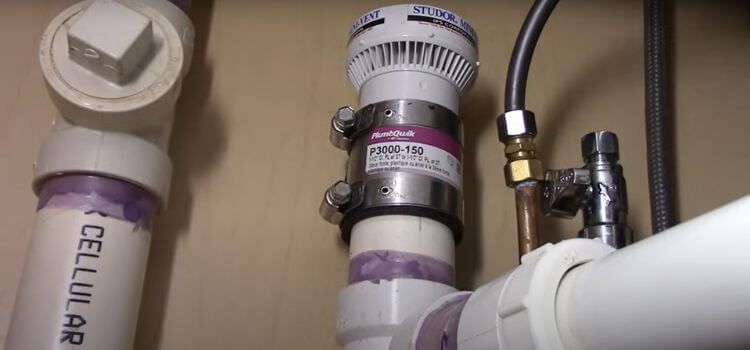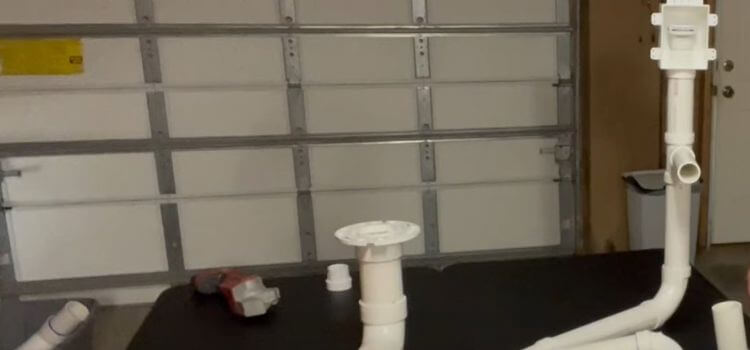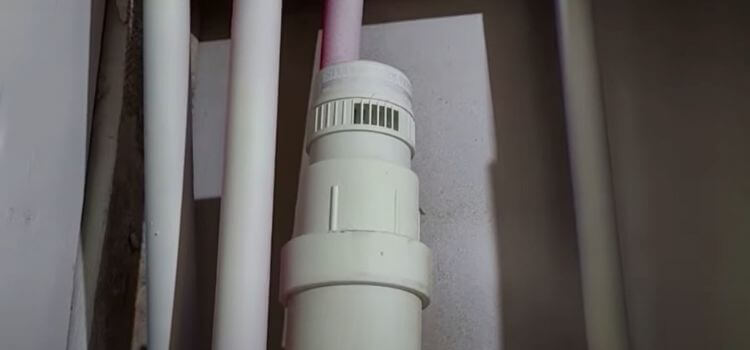An Air Admittance Valve (AAV) for a toilet is a device that allows air to enter the plumbing system. It prevents negative pressure and ensures proper drainage flow.
In modern plumbing, the Air Admittance Valve stands as a critical component, especially in situations where conventional venting is not practical or possible. Designed to replace the traditional vent pipe, an AAV opens to admit air into the drainage system when a vacuum occurs, preventing the siphoning of water from traps, which could lead to unwanted odours or sewer gases entering the home.
The valve’s unique mechanism allows it to automatically close under normal atmospheric pressure to maintain the integrity of the system and prevent the escape of gases. Its installation is straightforward, and it serves as an efficient solution to keep the necessary ventilation within your home’s plumbing network.
By ensuring the correct operation of waste systems, an AAV can be instrumental in upholding the health and safety standards of residential and commercial properties alike.
What Is An Air Admittance Valve?
An Air Admittance Valve (AAV) is a unique and ingenious device used in plumbing systems. It not only allows air to enter the plumbing system to facilitate proper water drainage but also acts as a barrier, preventing sewer gases from infiltrating your home. This valve functions like a one-way gate, opening to admit air when water flows through the pipes and sealing shut to block gases when the flow stops.
Function And Purpose
The primary function of an AAV is to maintain the right air pressure within the drainage system. This balance is crucial for:
- Preventing water locks: Ensures smooth water flow.
- Stopping sewer gases: Keeps unpleasant smells out.
- Enhancing venting: This avoids the need for complex pipe venting systems.
The purpose of AAVs is to provide a solution for homes where conventional venting is challenging or impossible to install. This makes AAVs an excellent choice for island sinks, remodels, and additional bathrooms, offering convenience and flexibility in your plumbing system.
Installation Locations
AAVs can be installed in various locations within your home’s plumbing system, depending on the specific needs and layout. Typical installation spots include:
- Under sinks: Easily accessible and hidden from view.
- Behind toilets: Ideal for bathrooms without existing vents.
- In basements: Useful for lower-level fixtures.
Correct installation is crucial for the AAV to function properly. It must be placed at a specific height relative to the fixtures it serves. Usually, it should be at least 4 inches above the horizontal branch drain or 6 inches above the highest flood level of the fixtures served.
| Location | Height Requirement |
|---|---|
| Horizontal branch drain | At least 4 inches above |
| Highest flood level | At least 6 inches above |
By understanding and implementing an Air Admittance Valve, homeowners can ensure efficient and safe plumbing systems that stand the test of time.

Advantages Of Using An Air Admittance Valve
When it comes to modern plumbing, an Air Admittance Valve (AAV) for toilets is a game-changer. These clever devices offer numerous benefits over traditional venting methods. Let’s explore the advantages of using an AAV in your bathroom setup.
Space-saving Design
The compact size of an AAV is a major plus. Traditional vent pipes can be bulky, taking up valuable space. An AAV’s sleek build allows for more room in small areas. This means more space for cabinets, shelves, or simply a more open bathroom design.
Cost And Time Efficiency
Installing a traditional vent system is costly and time-consuming. With an AAV, you save on materials like pipes and fittings. Labour costs drop as well since AAVs are faster and easier to install. This means a more budget-friendly bathroom renovation or build.
Flexibility In Installation
- Less Restrictive Placement: AAVs can be placed almost anywhere near the fixture, giving you design freedom.
- No Roof Penetration: Since they don’t need to connect to roof vents, you avoid potential leaks and structural issues.
- Perfect for Remodels: Upgrading your bathroom? An AAV can be added without a major plumbing overhaul.
Considerations Before Installing
Adding an Air Admittance Valve (AAV) to a toilet can be a smart move. But first, let’s consider some key points. These ensure the installation goes smoothly and adheres to all necessary standards.
Local Building Codes And Regulations
Staying compliant with local laws is crucial. Before installing an AAV, check with the local building authority. They provide guidelines that ensure safety and proper function.
Different areas have unique requirements. Some may not allow AAVs at all. It’s best to get this information upfront to avoid potential issues down the line.
Compatibility With Existing Plumbing Systems
Not all plumbing systems are ready for an AAV. It’s essential to assess the current setup thoroughly.
- Check the size and type of pipes.
- Ensure there’s enough space for the AAV.
- Verify the AAV model matches the system’s requirements.
Enlisting a professional plumber can provide valuable insights. They determine if an AAV is the right fit for the system.
Step-by-step Installation Guide
Ready to install an air admittance valve for your toilet? This guide walks you through each step. With the right tools and instructions, DIY plumbing is simpler than you think.
Required Tools And Materials
To start, gather these items:
- Pipe Wrench: For tightening connections.
- PVC Pipe Cutter: To cut pipes cleanly.
- Measuring Tape: For precise measurements.
- PVC Primer and Cement: Ensures strong pipe bonds.
- Air Admittance Valve: The main component.
- Thread Seal Tape: This is used to seal threaded joints.
- Hacksaw: Sometimes needed for pipe adjustments.
- Gloves and Safety Glasses: For your protection.
Installation Process
Follow these steps:
- Shut off the water supply to avoid spills.
- Measure and mark the vent pipe for the valve position.
- Use the pipe cutter to make a clean cut at the mark.
- Apply PVC primer, then cement to the pipe ends.
- Insert the air admittance valve and secure it firmly.
- Wrap thread seal tape around valve threads if needed.
- Tighten any connections with the pipe wrench.
- Turn the water back on and check for leaks.
With these steps, your valve is ready to prevent sewer gases from entering your home while allowing your drainage system to breathe.

Maintenance And Troubleshooting
Maintaining your air admittance valve (AAV) for your toilet is crucial. It keeps your plumbing system running smoothly. An AAV can face issues over time. Knowing how to troubleshoot can save you time and money.
Regular Maintenance Practices
Regular checks on your AAV help prevent problems. Ensure cleanliness to avoid clogs. Test the valve by running water and listening for air movement. Follow these steps for a healthy plumbing system:
- Inspect the AAV every few months.
- Clean the valve area to prevent debris build-up.
- Listen for unusual noises that could indicate a malfunction.
- Check local codes for maintenance requirements.
Common Issues And Solutions
AAVs can face certain problems. Identify and fix these issues to keep your toilet flushing properly.
| Issue | Solution |
|---|---|
| Valve not opening | Ensure no obstructions. Replace if needed. |
| Continuous odors | Check for leaks or cracks. Replace the valve. |
| Water not draining | Clean the valve. Check for proper installation. |
Follow these solutions to tackle common AAV issues:
- Remove any blockage around the valve.
- Replace the valve if it’s damaged or worn out.
- Ensure the AAV is installed correctly according to guidelines.
Comparing Air Admittance Valves With Traditional Venting Systems
When considering plumbing solutions for a toilet, two main options come into play: air admittance valves (AAVs) and traditional venting systems. Choosing the right one can impact not only the functionality of your toilet but also the installation process and overall costs. This section dives into the differences between AAVs and traditional venting to help you make an informed decision.
Efficiency And Effectiveness
Air admittance valves are designed for modern plumbing needs. They open to let air in, which helps to balance the pressure within the drainage system. This prevents water from being siphoned out of the traps, which could lead to sewer gases entering the home.
- AAVs are effective in maintaining the necessary airflow
- They eliminate the need for extensive pipework
- Installation is simple and quick, as they often require no roof penetration
In contrast, traditional venting systems rely on networks of pipes that extend to the roof. These systems are proven but can be more complex to install and maintain.
- They ensure long-term effectiveness in a variety of building structures
- Rooftop vents prevent sewer gases from entering by allowing air to escape
- They require regular maintenance to keep free from blockages
Cost And Labor Comparison
Costs and labour can be deciding factors when choosing between an AAV and a traditional vent. Here is a break of the differences:
| Aspect | Air Admittance Valves | Traditional Venting |
|---|---|---|
| Material Costs | Lower | Higher |
| Labor Costs | Lower | Higher |
| Installation Time | Shorter | Longer |
| Maintenance | Simpler | More Involved |
AAVs often offer immediate cost savings and ease of installation. The absence of extensive pipe networks and roof penetration can significantly reduce both material and labour expenses.
On the other hand, traditional venting systems, while more costly up-front, can be worth the investment for their reliability and longevity, especially in complex plumbing systems or larger buildings.
Common Myths And Misconceptions
When it comes to plumbing, the Air Admittance Valve (AAV) for toilets is often misunderstood.
Impact On Drainage System Performance
Myth: AAVs harm your drainage system’s efficiency. Truth: Quite the opposite!
- AAVs allow air to enter the plumbing system.
- This process helps wastewater flow smoothly.
- They prevent vacuum scenarios that can slow down drainage.
AAVs are designed to improve your system’s performance, not hinder it. They are vital in locations where conventional venting is not possible.
Long-term Reliability
Myth: AAVs are not durable and need constant replacement. Truth: AAVs are built to last.
| Feature | Benefit |
|---|---|
| Material | High-quality plastics resist corrosion. |
| Design | They operate with minimal moving parts. |
| Lifespan | AAVs can last as long as other plumbing components. |
Proper installation and occasional maintenance can ensure AAVs function effectively for many years.
Frequently Asked Questions
Can You Put An Air Admittance Valve On A Toilet?
Yes, you can install an air admittance valve on a toilet to help with venting. Ensure it is placed according to local building codes and above the toilet’s flood level to function properly.
Can You Put A Studor Vent On A Toilet?
Yes, you can install a Studor vent on a toilet to enable proper venting when traditional venting is not possible or practical.
What Is The Downside Of The Air Admittance Valve?
The downside of an air admittance valve (AAV) includes potential mechanical failure, a limited lifespan, and local building code restrictions. They may also be less effective in ventilating strong sewage odours than traditional venting methods.
Where Should The Air Admittance Valve Be Located?
An air admittance valve should be located within the vertical drain line, just above the drain trap and at least four inches higher than the horizontal branch drain. It must also be accessible for maintenance.
Conclusion
Understanding the role of air admittance valves in your toilet setup can save you from costly and messy plumbing issues. These clever devices maintain proper ventilation, prevent backflow, and promote a healthy plumbing system. Remember, correct installation and compliance with local codes are crucial for optimal performance.
Prioritize your home’s plumbing health by considering an air admittance valve for your toilet.

